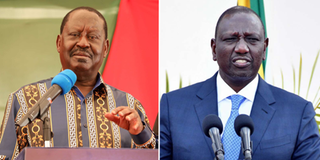Of Raila-Ruto rivalry, threats of mass protests and the literature of conflict

Raila Odinga (left) and President William Ruto.
“Okonkwo was well known throughout the nine villages and even beyond. His fame rested on solid personal achievements. As a young man of eighteen he had brought honour to his village by throwing Amalinze the Cat.
“Amalinze was the great wrestler who for seven years was unbeaten, from Umuofia to Mbaino. He was called the Cat because his back would never touch the earth.
“It was this man that Okonkwo threw in a fight which the old men agreed was one of the fiercest… The drums beat and the flutes sang and the spectators held their breath… In the end, Okonkwo threw the Cat”.
This duel between Okonkwo and Amalinze the Cat in Chinua Achebe’s novel, Things Fall Apart, brings to mind the political contest between former Prime Minister Raila Odinga and President William Ruto who have recently renewed their rivalry.
After his 2018 “Handshake” with former President Uhuru Kenyatta and immediately after losing the 2022 presidential election, the wild Odinga of yesteryears seemed a little subdued—domesticated, subjugated, a wild horse broken.
Also Read: Ruto raids Azimio strongholds
Many wondered if the final reckoning had come; terse, swift and unforgiving. At 77 years old, he is staring down the likelihood that he would never be president. After the elections, analysts wondered if he would ever roar again.
When Mr Odinga was younger, decades ago when he entered politics, many doors were still open; the presidency a heartbeat away. But now, like a failed lottery ticket, there are hardly any major doors seemingly open.
However, all doubts have now been put to rest after recent happenings. Politics still exerts an enduring pull for Mr Odinga. He won’t hang up his boots yet.
He recently announced that he was considering calling for mass protests before he called them off. And of late, he has been throwing critical zingers at President Ruto and his administration.
The tussle between Mr Odinga and President Ruto fits into the conflict that characterises great narratives. Conflict has been defined as “a struggle between opposing forces—two characters, a character and nature, or even an internal struggle.
Conflict is a major literary element that creates challenges and complexities in a story by adding uncertainty—and that’s what keeps readers hooked to a story. Conflict brings out the imperfections and tensions that keep us at the edges of our seats.
The Raila-Ruto conflict is a dizzying tale of power struggle. In the 2022 presidential election, these two were like restless soldiers—they fought for turf over Kenya’s political landscape in all its harshness and beauty, its golden promise, rapidly vanishing realities and incipient chaos.
The Raila-Ruto wrangle typifies a literary narrative because conflict also means “thwarted, endangered, or opposing desire”—when a character wants something but someone else stops him. Mr Odinga wanted the presidency but, in a melodramatic nightmare, President Ruto stopped him in his tracks.
Were it a novel, it would be unspeakably sad and some readers would empathise with Mr Odinga as he is growing older and his ambition to be president is somehow curtailed. There is also growing awareness of his finitude and failures, probably making him realise that the world is a far, far lonelier place.
For Mr Odinga, politics is the language of the heart and also the language of grief—a perpetual falling short of the high prize—sometimes really near the presidency, tantalisingly so, then not quite getting there.
And will that grief be a forever thing for him? One wonders if that loss follows him often even in his dreams; whether his heart cries out for the many milestones he did not have a chance to experience as president. If it were a novel, readers would emotionally connect with the story and find it hard to put down the book.
Mr Odinga is a master of political conflict. He often adds brinkmanship to it. Brinkmanship “is the practice of trying to achieve an advantageous outcome by pushing dangerous events to the brink of active conflict”.
By threatening to call for mass protests, he was pushing for a confrontation probably beyond the limit of safety as sometimes those protests turn violent. President Ruto was ruffled, and he responded.
Also Read: Raila vs Ruto - The case files
The president got the message. That was the whole point. And then Mr Odinga called off the protests. The ability to get to the verge without getting into active conflict is a masterful strategy. By that event alone of threatening to call for mass protests (and even before they happen), Mr Odinga has roared back and has announced that his unfinished struggle with President Ruto will continue.
Conflict is at the heart of politics as it is at the heart of any great literary narrative. And Mr Odinga knows how to play the conflict card. President Ruto won’t take it lying down.
They will clash again and again, probably having no idea what would happen next or where their narrative would take them. That’s the beauty of literature: not knowing everything. It’s the mystery that makes it interesting.
For the Raila-Ruto conflict, may it be all peaceful. As Chinua Achebe would write, “Let the hawk perch, let the eagle perch”. We may differ politically but we are all Kenyans under one flag.





